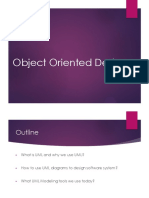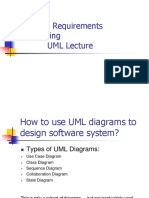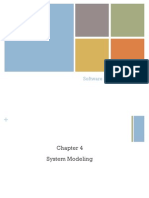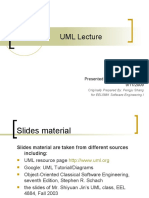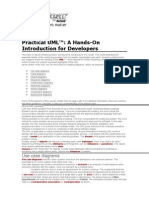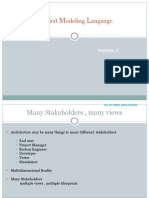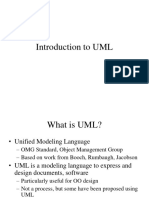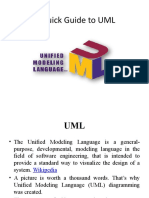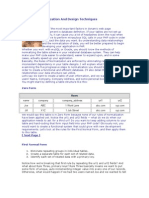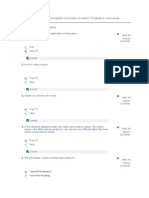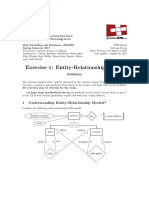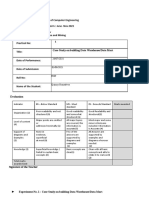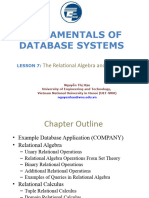EEL5881 Software Engineering I UML Lecture
Yi Luo
�About myself
Yi Luo TA for EEL5881 3rd Year Phd student in CpE Email: samprasluo@hotmail.com Office hour: Wednesday 3:00PM-5:00PM in HEC-365
�Acknowledgements
Slides material are taken from different sources including:
the slides of Mr. Shiyuan Jins UML class, EEL 4884, Fall 2003.
Object-Oriented and Classical Software Engineering, Sixth
Edition, WCB/McGraw-Hill, 2005 Stephen R. Schach
UML resource page http://www.uml.org/
�Outline
What is UML and why we use UML? How to use UML diagrams to design software system? What UML Modeling tools we use today?
�What is UML and Why we use UML?
UML Unified Modeling Language
Language: express idea, not a methodology Modeling: Describing a software system at a high level of abstraction Unified: UML has become a world standard
Object Management Group (OMG): www.omg.org
�What is UML and Why we use UML?
More description about UML:
It is a industry-standard graphical language for specifying, visualizing, constructing, and documenting the artifacts of software systems The UML uses mostly graphical notations to express the OO analysis and design of software projects. Simplifies the complex process of software design
�What is UML and Why we use UML?
Why we use UML?
Use graphical notation: more clearly than natural language (imprecise) and code (too detailed). Help acquire an overall view of a system. UML is not dependent on any one language or technology. UML moves us from fragmentation to standardization.
�What is UML and Why we use UML?
Year Version
2003: 2001: 1999: 1997: 1996: 1995: UML 2.0 UML 1.4 UML 1.3 UML 1.0, 1.1 UML 0.9 & 0.91 Unified Method 0.8
Booch 93 Other methods Booch 91
OMT - 2
OMT - 1
�How to use UML diagrams to design software system?
Types of UML Diagrams:
Use Case Diagram Class Diagram Sequence Diagram Collaboration Diagram State Diagram
This is only a subset of diagrams but are most widely used
�Use-Case Diagrams
A use-case diagram is a set of use cases A use case is a model of the interaction between
External users of a software product (actors) and The software product itself More precisely, an actor is a user playing a specific role
describing a set of user scenarios capturing user requirements contract between end user and software developers
�Use-Case Diagrams
Boundary Actor
Library System
Use Case
Borrow
Employee
Client
Order Title
Fine Remittance
Supervisor
�Use-Case Diagrams
Actors: A role that a user plays with respect to the system, including human
users and other systems. e.g., inanimate physical objects (e.g. robot); an external system that needs some information from the current system.
Use case: A set of scenarios that describing an interaction between a user
and a system, including alternatives.
System boundary: rectangle diagram representing the boundary between
the actors and the system.
�Use-Case Diagrams
Association:
communication between an actor and a use case; Represented by a solid line.
Generalization: relationship between one general use case and a special use
case (used for defining special alternatives) Represented by a line with a triangular arrow head toward the parent use case.
�Use-Case Diagrams
Include: a dotted line labeled <<include>> beginning at base use case and ending with an arrows pointing to the include use case. The include relationship occurs when a chunk of behavior is similar across more than one use case. Use include in stead of copying the description of that behavior.
<<include>>
Extend: a dotted line labeled <<extend>> with an arrow toward the base case. The extending use case may add behavior to the base use case. The base class declares extension points.
<<extend>>
�Use-Case Diagrams
Figure 16.12
The McGraw-Hill Companies, 2005
�Use-Case Diagrams
Both Make Appointment and Request Medication include Check Patient Record as a subtask (include)
The extension point is written inside the base case Pay bill; the extending class Defer payment adds the behavior of this extension point. (extend)
Pay Bill is a parent use case and Bill Insurance is the child use case. (generalization)
(TogetherSoft, Inc)
�Class diagram
A class diagram depicts classes and their interrelationships Used for describing structure and behavior in the use cases Provide a conceptual model of the system in terms of entities and their relationships Used for requirement capture, end-user interaction
Detailed class diagrams are used for developers
�Class diagram
Each class is represented by a rectangle subdivided into three compartments
Name Attributes Operations
Modifiers are used to indicate visibility of attributes and operations.
+ is used to denote Public visibility (everyone) # is used to denote Protected visibility (friends and derived) - is used to denote Private visibility (no one)
By default, attributes are hidden and operations are visible.
�Class diagram
Account_Name - Customer_Name - Balance
Name Attributes Operations
+addFunds( ) +withDraw( ) +transfer( )
�OO Relationships
There are two kinds of Relationships
Generalization (parent-child relationship) Association (student enrolls in course)
Associations can be further classified as
Aggregation Composition
�OO Relationships: Generalization
Supertype
Example:
Customer
Regular Customer
Loyalty Customer
Subtype1
Subtype2
-Inheritance is a required feature of object orientation
-Generalization expresses a parent/child relationship among related classes. -Used for abstracting details in several layers
�OO Relationships: Association
Represent relationship between instances of classes
Student enrolls in a course Courses have students Courses have exams Etc.
Association has two ends
Role names (e.g. enrolls) Multiplicity (e.g. One course can have many students) Navigability (unidirectional, bidirectional)
�Association: Multiplicity and Roles
student 1 University 0..1 employer
Multiplicity
Symbol 1 0..1 M..N * 0..* 1..* Meaning One and only one Zero or one From M to N (natural language) From zero to any positive integer From zero to any positive integer From one to any positive integer
* Person * teacher Role Role
A given university groups many people; some act as students, others as teachers. A given student belongs to a single university; a given teacher may or may not be working for the university at a particular time.
�Class diagram
[from UML Distilled
Third Edition]
�Association: Model to Implementation
Student
* has
4 enrolls
Course
Class Student { Course enrolls[4]; } Class Course { Student have[]; }
�OO Relationships: Composition
Class W
Whole Class
Association
Models the partwhole relationship
Composition
Class P1 Class P2
Part Classes [From Dr.David A. Workman] Example
Also models the partwhole relationship but, in addition, Every part may belong to only one whole, and If the whole is deleted, so are the parts
Example:
A number of different chess boards: Each square belongs to only one board. If a chess board is thrown away, all 64 squares on that board go as well.
Figure 16.7 The McGraw-Hill Companies, 2005
�OO Relationships: Aggregation
Container Class Class C AGGREGATION
Aggregation:
expresses a relationship among instances of related classes. It is a specific kind of ContainerContainee relationship.
Class E1
Class E2
express a more informal relationship than composition expresses. Aggregation is appropriate when Container and Containees have no special access privileges to each other.
Containee Classes
Example
Bag
Apples
Milk
[From Dr.David A. Workman]
�Aggregation vs. Composition
Composition
is really a strong form of association
components have only one owner components cannot exist independent of their owner components live or die with their owner e.g. Each car has an engine that can not be shared with other cars. Aggregations may form "part of" the association, but may not be essential to it. They may also exist independent of the aggregate. e.g. Apples may exist independent of the bag.
�Good Practice: CRC Card
Class Responsibility Collaborator easy to describe how classes work by moving cards around; allows to quickly consider alternatives.
�Interaction Diagrams
show how objects interact with one another UML supports two types of interaction diagrams
Sequence diagrams Collaboration diagrams
�Sequence Diagram(make a phone call)
Caller
Picks up Dial tone
Phone
Recipient
Dial
Ring notification Ring
Picks up
Hello
�Sequence Diagram:Object interaction
A B Synchronous
Self-Call: A message that an Object sends to itself. Condition: indicates when a message is sent. The message is sent only if the condition is true.
Asynchronous Transmission delayed [condition] remove()
Condition
*[for each] remove()
Iteration
Self-Call
�Sequence Diagrams Object Life Spans
Creation A Create message Object life starts at that point Activation Symbolized by rectangular stripes Place on the lifeline where object is activated. Rectangle also denotes when object is deactivated. Activation bar Deletion Placing an X on lifeline Objects life ends at that point Lifeline
Create
Return
X
Deletion
�Sequence Diagram
User
Message
1: look up () 2: title data ()
Catalog
Reservations
Sequence diagrams demonstrate the behavior of objects in a use case by describing the objects and the messages they pass. The horizontal dimension shows the objects participating in the interaction.
3: [not available] reserve title ()
4 : title returned () 5: hold title () 5 : title available ()
The vertical arrangement of messages indicates their order. The labels may contain the seq. # to indicate concurrency.
6 : borrow title ()
6 : remove reservation ()
�Interaction Diagrams: Collaboration diagrams
start 6: remove reservation 3 : [not available] reserve title User 6 : borrow title 2: title data 1: look up 5: title available Reservations
4 : title returned Catalog 5 : hold title
Collaboration diagrams are equivalent to sequence diagrams. All the features of sequence diagrams are equally applicable to collaboration diagrams Use a sequence diagram when the transfer of information is the focus of attention
Use a collaboration diagram when concentrating on the classes
�State Diagrams (Billing Example)
State Diagrams show the sequences of states an object goes through during its life cycle in response to stimuli, together with its responses and actions; an abstraction of all possible behaviors.
Start
Unpaid
Invoice created paying
End
Paid
Invoice destroying
�State Diagrams (Traffic light example)
Traffic Light
Start
State Transition Red Yellow Green
Event
�What UML Modeling tools we use today?
List of UML tools http://en.wikipedia.org/wiki/List_of_UML_tools ArgoUML: http://argouml.tigris.org/ Rational Rose (www.rational.com) by IBM UML Studio 7.1 ( http://www.pragsoft.com/) by Pragsoft Corporation: Capable of handling very large models (tens of thousands of classes). Educational License US$ 125.00; Freeware version. TogetherSoft Control Center; TogetherSoft Solo (http://www.borland.com/together/index.html) by Borland
�Conclusion
UML is a standardized specification language for object modeling Several UML diagrams:
use-case diagram: a number of use cases (use case models the interaction between actors and software) Class diagram: a model of classes showing the static relationships among them including association and generalization. Sequence diagram: shows the way objects interact with one another as messages are passed between them. Dynamic model State diagram: shows states, events that cause transitions between states. Another dynamic model reflecting the behavior of objects and how they react to specific event
There are several UML tools available
�Thank you
Questions?







